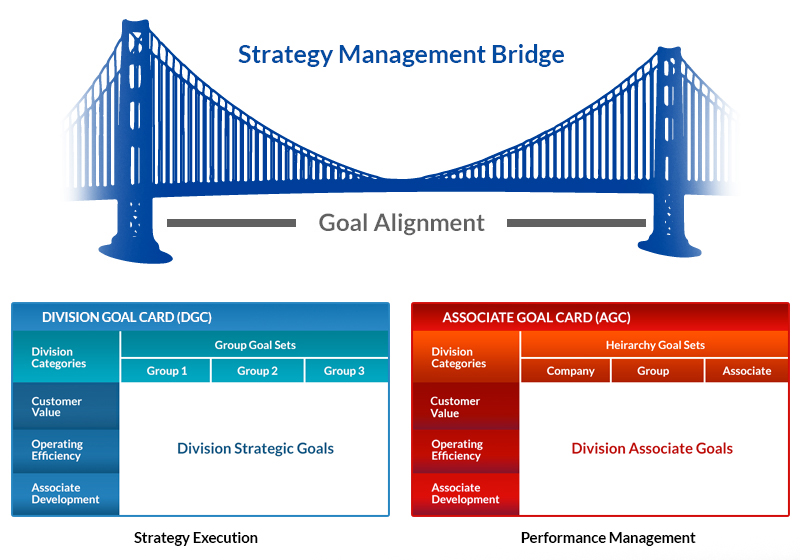BRIDGING THE GAP
Tying Associate Goals to
Organization Strategy
Tying Associate Goals to
Organization Strategy
Proprietary Manage-By-Milestone (MBM) functionality creates the seamless interface in V2R that bridges the gap between Strategy Execution and Performance Management. MBMs easily cascade the DGC strategies down to “No Excuses” associate level goals.
Strategy Execution is the highest level process that in most organizations is driven by their leadership team. Conversely, Performance Management is viewed as a more tactical process that is often relegated to Human Resources.
Departmentalizing the Strategy Execution and Performance Management systems into functional groups or silos that focus on local optimums is the primary cause of the Strategy Management gap. An organization’s failure to bridge this gap will result in wasted resources, low morale and no accountability that collectively prevent Strategy Execution from occurring.

Strategy Execution and Performance Management both impact every associate in a Division. Building a Strategy Management bridge requires the alignment of every associate directly with their portion of the Division’s strategy that they must achieve in an effective and timely manner. Completing strategic initiatives on top of managing the day-to-day operations will always be a huge challenge for even the most agile organizations. V2R’s Manage-By-Milestone (MBM) functionality bridges the Strategy Management gap by aligning each Division’s strategy with the “No Excuses” associate level goals required to achieve it.
Gap Assignment creates accountability threads throughout a Division and between Divisions from their highest level strategies to the lowest level associate goals. These accountability threads form the virtual bridge that spans the Division’s Strategy Execution to Performance Management gap. MBMs are used by Managers (i.e. Project Sponsors) to assign Owners (i.e. Project Managers) to each of a Division’s highest level strategies. These assignments hold them both accountable for achieving the assigned strategy. MBMs are used again by the Owners (i.e. Project Managers) to cascade lower level associate goals to all teammates assigned to their project.
The assignment of Managers and Owners to a goal holds them both accountable for achieving it. V2R allows an unlimited number of these lower level goal assignments. In addition, Stakeholders may also be assigned to each Division strategy and associate goal to clarify upstream, downstream and subordinate relationships. Stakeholders can then optionally rate the subjective performance of the Goal Owner based on its customized Rating Table when the goal has been completed.
Contemporaneous Actions are used to document achievements, feedback and corrective actions between Goal Managers and Owners. Goal Managers use MBMs to provide their assigned Owners ongoing feedback and suggest corrective actions required to assure timely completion within budget. Owners are responsible for reporting their Past Actions, Current Risks and Future Plans required to achieve their assigned goals.
Most people have rather short memories that can bias the assessment of a completed strategy or goal based on what happened during the last couple weeks. The contemporaneous Actions documented in V2R during the management phase of a strategy or goal’s life are readily available for review during the assessment process. These Actions serve to refresh the memories of all Stakeholders to assure completed strategies and goals are assessed fairly.
In addition, V2R triggers assessments when strategies or goals are completed, rather than waiting for memories to fade by year end or on an associate’s anniversary. Associate level accountability in V2R drives achievement of assigned initiatives to be on time and within budget. Transparency promotes accountability that creates peer pressure across an organization for all associates to honor their commitments.

